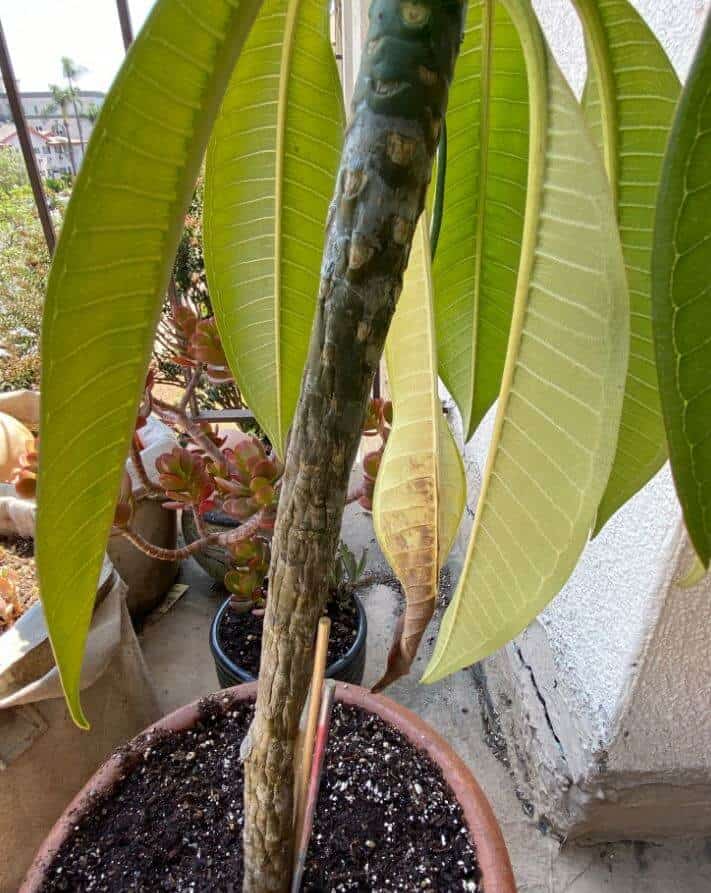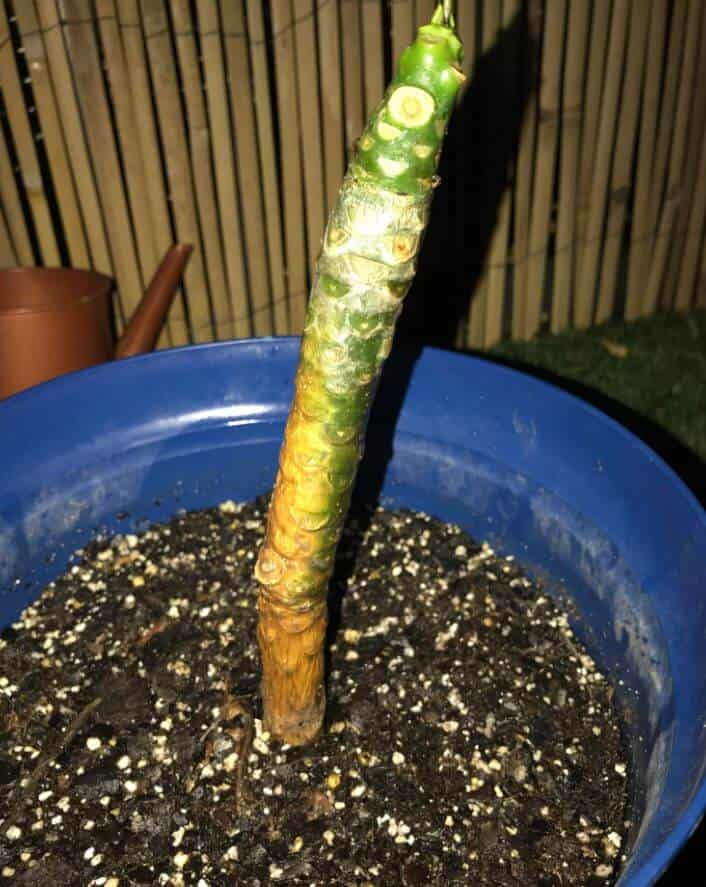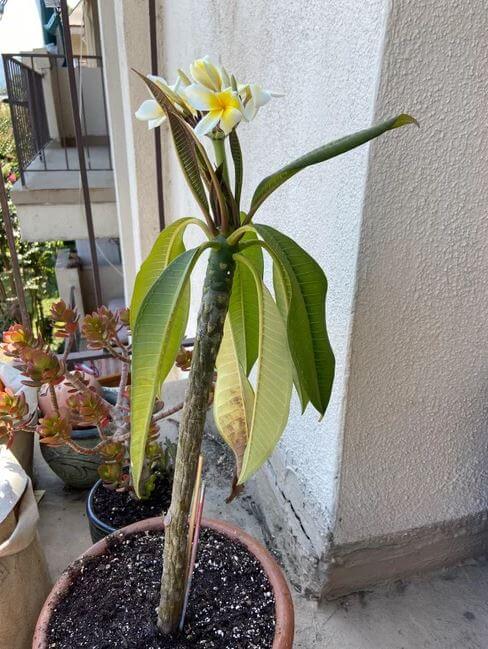Last Updated on February 21, 2023 by a Friendly Gardener
Plumerias are relatively strong plants that have very few problems, but when they do, it’s usually because of excessive care. Overwatering is one of the principal causes of troubles, with stem rot heading the list of serious conditions. The other extreme, plumeria dehydration however can be just as dangerous.
In both cases, water is at the root of your plant’s distress. Symptoms of too little water might include leaves and flowers dropping, crispy, dry leaves, or stunted growth. Excessive watering is characterized by flowers or lower leaves rotting, yellowing foliage, bud drop, and stem and root rot.
What Is Plumeria Stem Rot?

Stem rot is a fungal infection that can lead to the death of a plant. This disease can have several causes. It is characterized by the plant’s excessive wetness, yet it inhibits water from reaching the foliage and will render the plant stems soft. This infection generally begins in the root system but can move up damaged stems where water accumulates because of the infection.
Stem rot can attack both younger and more mature plumeria and develops because the plant is too humid. Excess environmental humidity can be challenging with indoor cultivation, but your Plumeria will signal that it is in distress.
The first symptom will be dropping leaves. Dropping foliage is usually caused by stem rot but it can also be a symptom of blacktip fungus. Both infections are the result of soggy soil or overly wet foliage. The obvious solution is to water less.
Plumeria Stem Rot also attacks hollow stem cavities often caused by spider mites. As the mites eat the plant, small holes appear allowing fungal spores to enter stems and create havoc.
Identifying and Treating Plumeria Stem Rot
When a Plumeria exhibits black mushy stems with hollow centers, it has stem rot. A spot or stain on the stem left unattended can result in the entire stem turning black.
Stems with black spots on the outside indicate that the center is hollow. This can be root rot traveling up the stem or parasites attacking the plant. Stem rot caused by root rot will be evident because it begins just above the soil bed surface. Stains higher up on stems are generally caused by pest infestations. In these cases, you will have to treat both the fungal infection and the pests.
How to Fix Plumeria Stem Rot

Your best option is to treat the first sign with a fungicide. If, however, your plant has several stems and shows new growth below the stem rot stain, you may opt to prune your plant’s stems an inch below the infection stain.
Pruning roots is also used to cure stem rot, particularly in plants cultivated indoors. Removing rotting roots allows infected plants to grow new healthy roots in their place.
Examine Plumeria stems carefully for mushy, soft areas or black stains on lower leaves. Clean the plant with cotton and rubbing alcohol wherever you think fungi are a problem. Once cleaned, if stem rot is in the very beginning stages, just keep the plant dry and water only of the soil bed completely dries out. Apply Neem oil or a fungicide weekly.
If the stem rot is extensive, use pruning to remove affected areas including stems, leaves, or roots. If the entire root system is infected, you will need to create a new plant using a healthy stem cutting and dispose of the rest.
Stem Rot on Young Plumeria Plants and Cuttings

If you have just planted a Plumeria or are attempting to root plumeria cuttings in water, your Plumeria will be more at risk for stem rot.
Rooting Plumeria in water allows the cutting to develop roots specifically for water, so when you transplant it, it may experience transplant shock. Consequentially, the cutting will search for more water, but the roots will be thinner and weaker than soil roots, making your new plantlet more susceptible to disease. It will rot from the base up.
Winter Burn, Black-Tip Fungus, or Plumeria Stem Rot?
Winter Burn generally appears during a Plumeria’s dormancy. Winter burn manifests itself with dried rot around stems and brown lesions. This is generally caused by a combination of humidity, winter sun heat, or indoor heating that dry out stems causing them to split so that fungus attacks. Winter burn is identifiable because it appears in a small, limited area. Remove affected plant parts.
Black Tip Fungus is another kind of fungal infection. Pest can be the cause as they damage stems allowing humidity and fungus to enter. This fungal infection is easier to resolve with several fungicide treatments, and by removing any infected tips.
Preventing Plumeria Stem Rot
The best method for preventing this fungal infection is through limited watering. If the soil bed is damp, wait to water. If it is very soggy, repot your plant is fresh drier, and better-draining soil.
What Is Plumeria Dehydration?

Dehydration is caused by too little water. When a plant does not receive adequate water, it can die. Your plumeria needs water to function.
Proper watering ensures a Plumeria’s ability to:
- Remain rigid and upright.
- Photosynthesize for nourishment.
- Send nutrients from the soil bed up the stem to foliage.
- Avoid exaggerated leaf and bud drops.
- Prevent blossoms from fading rapidly.
Classic signs of a dehydrated Plumeria include:
- A Plumeria will begin to wilt. A lack of water will result in your plant losing its turgor. This is the natural rigidity found in tissues and cells. While various infections can cause wilting the most common cause is dehydration due to underwatering.
- The soil bed will appear very dry.
- Plumeria leaf tips may appear dry and dead. When plants are dehydrated, they often develop brown dried-out edges and tips. Eventually, the entire leaf will die.
- New Plumeria growth is very slow and new foliage may be very small in size.
A rapid method for determining if dehydration is the problem is to water your Plumeria. The plant should revive relatively quickly. If it does not, you may be dealing with a fungal or viral disease. Yellowing foliage can also be a sign of too little water, or too much.
Dehydrated Plumeria Cuttings
A Plumeria cutting wrinkled signals dehydration. You can soak your cutting for approximately four hours to rehydrate it.
Proper Hydration for the Plumeria

Plumerias do not do well with overwatering or underwatering. They need to be watered thoroughly and then allowed to dry out somewhat before watering anew. Toward the middle of the fall season, watering should be reduced. When your Plumeria enters dormancy, stop watering altogether. You can resume watering once new growth appears at the beginning of the spring season.

